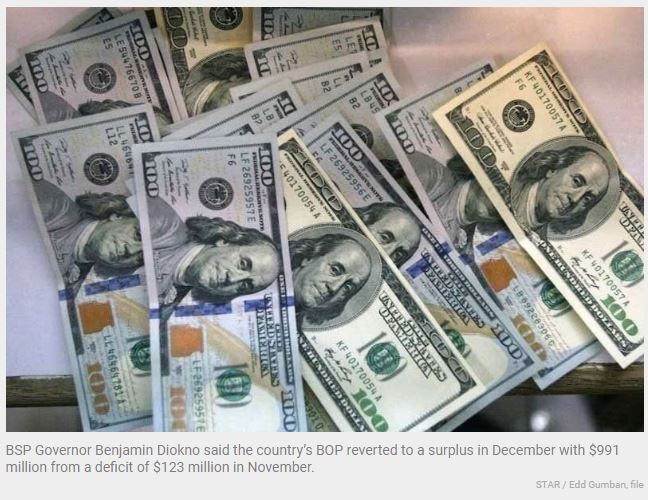Philippines’ dollar position lands in deficit in February
MANILA, Philippines — The national government’s foreign currency debt payments sent the country’s dollar position into familiar territory as it settled into a deficit in February.
Data provided by the Bangko Sentral ng Pilipinas on Monday showed the country’s balance of payments position landed in a deficit of $895 million in February. This was larger than the $157 million deficit recorded a year ago.
The BOP is a summary of the country’s transactions with the world for a specific period of time. A deficit happens when foreign fund outflows exceed inflows.
Despite this, the country’s BOP position stood at a surplus of $2.2 billion in the first two months of 2023 owing to inflows from the government’s Global Bond issuance, as well as remittances from Filipino expats and foreign portfolio investments.
The BSP noted that the latest BOP position stemmed from foreign currency debt servicing.
“The BOP deficit in February 2023 reflected outflows arising mainly from the National Government’s net foreign currency withdrawals from its deposits with the BSP to settle its foreign currency debt obligations and pay for its various expenditures,” the statement read.
Nicholas Antonio Mapa, senior economist at ING Bank in Manila, attributed the shortfall to the persisting trade deficit. The country’s trade balance opened the year in a deficit as exports of Filipinos goods sank in January.
“Financial account also likely saw stark outflows given heightened uncertainty in financial markets and slow pickup of foreign direct investments,” Mapa said in a Viber message.
Data broken down showed the country’s dollar reserves retreated to $98.2 billion in February. The level represents a buffer equivalent to 7.4 months’ worth of imports of goods and services. This is about 5.9 times the country’s short-term external debt based on original maturity and 3.9 times based on residual maturity.
Zooming out, the central bank unveiled a new set of projections for this year and the next.
The BSP already trimmed its BOP projection for 2023. For this year, the new forecast pegged a $1.6 billion deficit, from the previous $5.4 billion. The central bank projected the BOP position would amount to a $500 million deficit in 2024.
The latest projections reflect a dimmer view of the global and domestic economy, as headwinds continued to weigh down expectations. Rising inflation and Russia’s invasion of Ukraine comprised headwinds that the BSP expected will roil the Philippine economy.
As it is, the latest BOP deficit forecast is equivalent to 0.4% of the country’s gross domestic product. The forecast means more dollars would leave the country than those that would enter.
A BOP deficit also means a weaker currency, which could further bloat import costs. For this year, the BSP’s outlook on foreign trade was gloomy. Exports would grow at a slower clip of 3%, while imports are expected to sputter by 4%.
If the export forecast is realized, it would be lower than the 5.9% annual growth in 2022 as global supply chain disruptions and higher input costs hampered demand for Filipino products despite renewed economic activity everywhere.
The BSP left its forecast on BPO receipts unchanged at 9% for 2023 and 2024.
On the other hand, its tourism receipts forecast reflected the BSP’s grim outlook of the global economy. Travel receipts are expected to grow 80% year-on-year in 2023, then slow down to 50% annual growth in the following year. This was a far cry from 595.4% expansion last year, as the tourism sector cornered a supposed trend of “revenge spending.”
Source: https://www.philstar.com/business/2023/03/21/2253316/philippines-dollar-position-lands-deficit-february


 Thailand
Thailand




